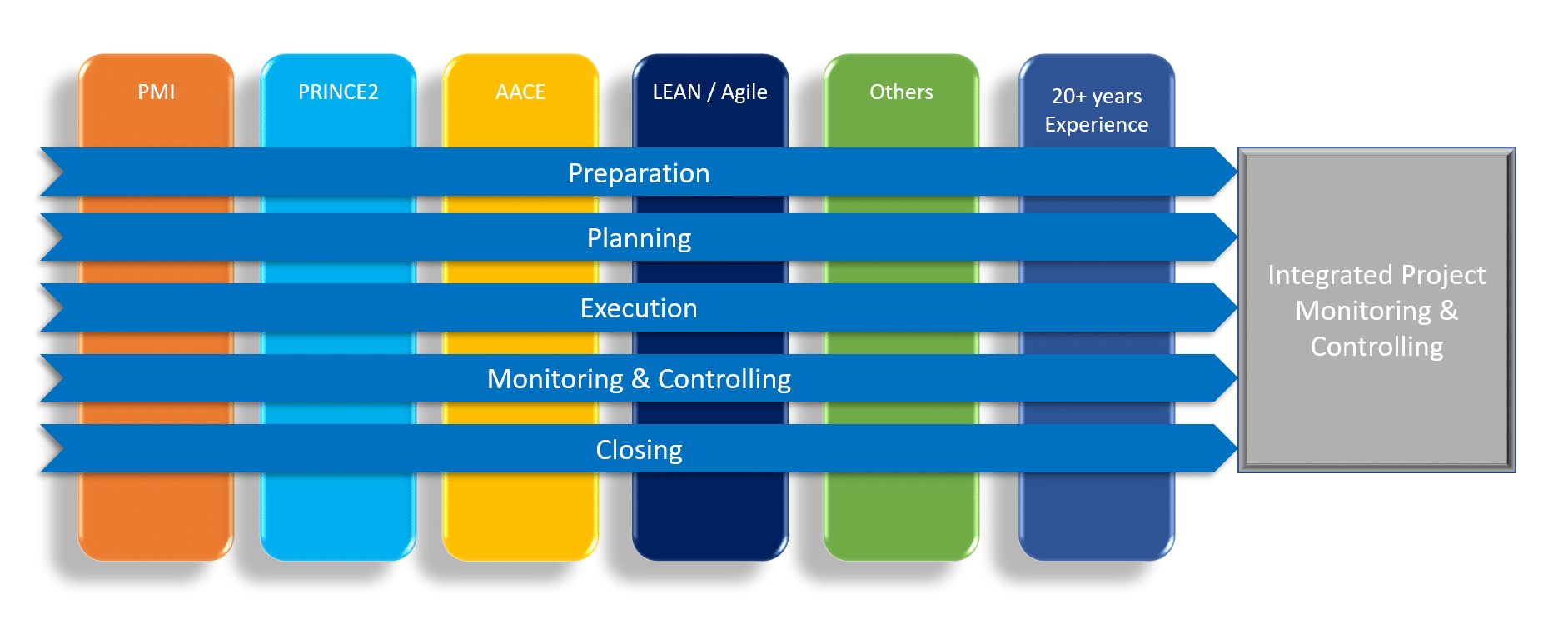- Uncategorized
- 27 Apr 2020
Best Practices based Integrated Project Monitoring & Control

Successful projects deliver their scope with quality within the agreed upon time and cost. Integrated Monitoring and Controlling of schedule, scope, cost, risks, resources and quality throughout the project’s life cycle starting from project planning till the asset transition is mandatory for project success. While most of the leading project management frameworks like PMBOK by the Project Management Institute (PMI), PRINCE2 by Axelos, TCM framework by AACE, LEAN and Agile support this, each one of them have their strengths. While some are well suited for traditional projects with longer milestones (EPC), others fit well for projects which calls for inter-disciplinary team work within shorter milestones (R&D, Early phases of EPC, Snagging etc).
Though this kind of segmentation of projects based on frequency of milestones and interdisciplinary coordination is effective from the academic perspective, in reality all EPC projects have phases of shorter and longer milestones with varying degree of inter disciplinary coordination needs. Hence by sticking to any one particular framework while defining the Integrated Project Monitoring and Control strategy will result in sub-optimal monitoring and control. With this as the case, we at Wrench Academy conducted substantial research cutting across the leading project management frameworks to provide the best of the best practices approach to Integrated Project Monitoring and Control (IPMC).
Overview of the leading frameworks
Project Management Body Of Knowledge (PMBOK)
PMBOK by the Project Management Institute (USA) is the most popular among the project management frameworks. It comprises of 49 processes grouped into 10 knowledge areas of;
- Project integration management
- Scope management
- Schedule management Cost management
- Quality management
- Resource management
- Communications management
- Risk management
- Procurement management
- Stakeholder management
The coverage of this framework is excellent as it covers most of the aspects of professional project management.
Projects in Controlled Environment (PRINCE2)
PRINCE2 is the British standard for project management maintained by Axelos. PRINCE2 is a structured process-based approach to project management. The processes comprise of;
- Starting up a project
- Directing a project
- Initiating a project
- Managing stage boundaries
- Planning
While there are lot of commonalities between PMBOK and PRINCE2, PRINCE2 is highly prescriptive in nature when compared to PMBOK.
Total Cost Management (TCM)
The Total Cost Management (TCM) framework by AACE is an integrated approach to Portfolio, Program and Project Management. TCM is a systematic approach to managing cost throughout the life cycle of any enterprise, program, facility, project, product or service. Comprises of;
- Strategic asset planning
- Project implementation
- Strategic asset performance measurement
- Strategic asset performance assessment
- Project control planning
- Project control plan implementation
- Project control measurement
- Project control performance assessment
What differentiates the TCM framework from other frameworks is its depth of coverage of the topics through Recommended Practices (RP) by the practitioners.
LEAN
Lean project management is the application of lean concepts such as lean construction, lean manufacturing and lean thinking to project management. The main principle of lean project management is delivering more value with less waste in a project context. Two well-known types are “Kanban” and “Last Planner System”.
Agile
Agile project management using SCRUM framework is the most popular framework within the Agile family of frameworks. SCRUM is a very simple framework for self-organizing teams to collaborate and deliver increments of the products in shorter iterations. Though agile project management (APM) have its roots in information technology domain there are many early adopters for it in EPC projects reporting positive results especially during early phases of engineering, execution and snagging.
The Best Practices Based Integrated Project Monitoring & Control
After detailed research of the above frameworks combined with our more than two decades of experience of working with projects, we defined the best practices-based project monitoring and control approach by picking up the best of the best practices cutting across project management frameworks.

Phase#1 Preparation
Focus – Get ready for the planning phase
- Scope definition (PMBOK, TCM, PRINCE2,Agile)
- Stakeholder identification (PMBOK)
- Role definition (PMBOK, TCM, PRINCE2, Agile)
- High level risk definition (PMBOK, TCM, PRINCE2)
- Information dissemination (PMBOK)
Phase#2 Planning
Focus – Plan in a way to facilitate almost real time project progress monitoring & controlling and forecasting
- Work Breakdown Structure definition (WBS) – (PMBOK, TCM, PRINCE2, Agile)
- Organization breakdown structure definition (OBS) – (PMBOK, PRINCE2, TCM, Agile)
- Establishing WBS-OBS linkages (PMBOK, TCM)
- Resource Breakdown Structure (RBS) – (PMBOK, TCM, Agile)
- Estimation & Budgeting (PMBOK, TCM, Agile)
- Cost breakdown structure (PMBOK, TCM)
- Schedule development (PMBOK, TCM, Agile)
- Rules of credit (TCM)
- Interfaces with other systems (Experience)
- Plan communications (PMBOK, TCM)
- Quality planning (PMBOK, TCM, PRINCE2)
- Risk planning (PMBOK, TCM, PRINCE2)
- Contingency planning (PMBOK, TCM)
Phase#3 Execution
Focus – Collect accurate and timely execution data. Control the dynamic incidents
- Project execution data capture (PMBOK, TCM, Agile, Experience)
- Change control (PMBOK, TCM, PRINCE2)
- Quality management (PMBOK, TCM)
- Risk control (PMBOK, TCM)
- Contingency management (TCM)
- Communication (PMBOK, TCM, Agile)
Phase#4 Monitoring & Controlling
Focus : Provide almost real time project status information to key stakeholders. Control quickly.
- Planned Value (PMBOK, TCM, Agile)
- Earned Value (PMBOK, TCM, Agile)
- Actual Cost (PMBOK, TCM)
- Variance analysis (PMBOK, TCM, Agile)
- Forecasting Schedule & Cost (PMBOK, TCM, Agile)
- Control schedule (PMBOK, TCM)
- Control costs (PMBOK, TCM)
- Forensic analysis (TCM)
- Control quality (PMBOK, TCM)
- Snag management (TCM, Experience)
- Risk monitoring (PMBOK, TCM)
Phase#5 Closing
Focus : Learning, Asset transition
- Formal closure (PMBOK, TCM)
- Asset transition (PMBOK, TCM)
Conclusion
The biggest problem project managers face across the globe are lack of project information on time for decision making. An integrated approach to project monitoring and controlling can solve this problem by providing almost real time project status information and the ability to forecast expected date and cost of completion.
Since every project management framework has their own strengths, it is advisable to cut across the various frameworks to choose the most appropriate best practices to support the integrated project monitoring and control function of your project.
References
Expert in agile, predictive and hybrid project management. Researches on the application of Artificial Intelligence for better project outcomes. Works as a domain expert at Wrench Academy, the knowledge management division of Wrench Solutions, the makers of Smart Project Digital PMO.
Archives
- March 2025
- February 2025
- January 2025
- November 2024
- October 2024
- September 2024
- August 2024
- July 2024
- June 2024
- May 2024
- April 2024
- March 2024
- January 2024
- December 2023
- November 2023
- September 2023
- August 2023
- July 2023
- June 2023
- May 2023
- April 2023
- March 2023
- February 2023
- January 2023
- December 2022
- November 2022
- September 2022
- June 2022
- May 2022
- April 2022
- March 2022
- January 2022
- November 2021
- October 2021
- July 2021
- June 2021
- May 2021
- March 2021
- February 2021
- January 2021
- December 2020
- November 2020
- September 2020
- August 2020
- June 2020
- April 2020
- March 2020
- February 2020
- January 2020
- November 2019
- October 2019
- September 2019
- August 2019
- April 2019
- March 2019
- December 2018
- October 2018
- September 2018
- August 2018
- July 2018
- June 2018
- May 2018
- April 2018
- January 2018
- November 2017
- October 2017
- September 2017
- May 2017
- April 2017
- March 2017
- February 2017
- January 2017
